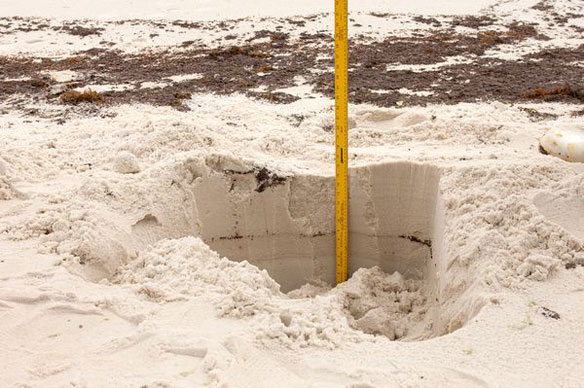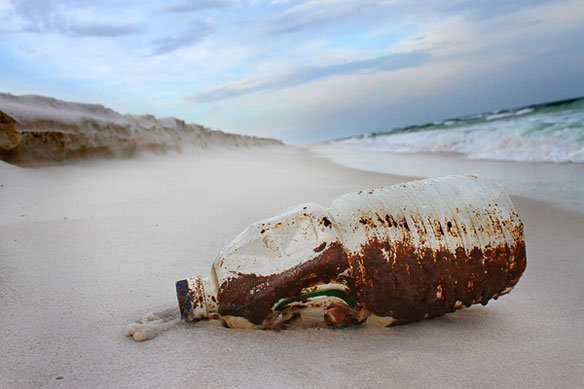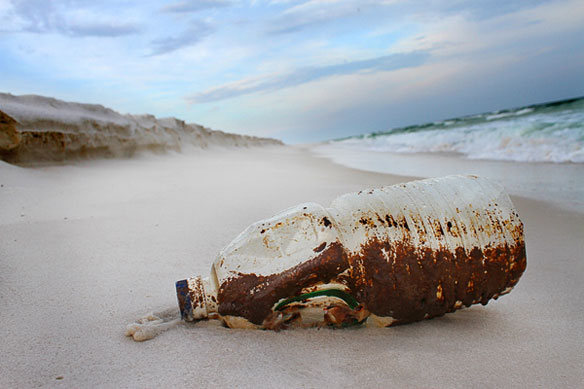
Buried oil patty on Pensacola Beach, Florida, found even after cleanups. Photo Source: Chris Combs/National Geographic
By Ben Raines, Press-Register
Friday the Gulf Coast Incident Management Team released a report from its interagency Operational Science Advisory Team 2 about oil from the BP Deepwater Horizon Oil Spill that remains on or near sandy beaches along the Gulf Coast. Titled “Summary Report for Fate and Effects of Remnant Oil in the Beach Environment,” the report examines data sampled from four representative beaches at Grand Isle, La., Petit Bois Island, Miss., Bon Secour, Ala., and Fort Pickens, Fla.
Federal officials released a report Friday that suggests cleanup operations have removed as much oil as is practical from most shorelines in Alabama, Mississippi, Florida and Louisiana.
Further cleanup in many areas, the report argues, will do more harm to the environment than leaving the remaining oil in place.
Titled, “Summary Report for Fate and Effects of Remnant Oil in the Beach Environment” the report was drafted by the federal science advisory team studying the BP PLC oil spill in the Gulf.
Its conclusions mirror comments the science group made when drafting the “no further treatment” standards for the cleanup several months ago.
Submerged mats of oil still being discovered just off the beaches in Alabama, Mississippi, and Florida are considered an exception to the rule that further cleanup will do more damage, according to the report. The submerged oil still contains many of the more-toxic compounds present in crude, while the tarballs on the beaches are more weathered and less dangerous, according to the report.
Aside from the mats, the remaining oil, which the report suggests is either buried under a few inches of sand or present in small tarballs on the beach, poses little threat to humans or wildlife, the report concludes. It documents some areas where the “no further treatment” standard has been reached, including parts of Petit Bois Island and parts of the Fort Morgan peninsula.
“Environmental impacts of remnant oil found on or near beaches after cleanup operations are relatively minor,” reads the report. “Cleanup operations beyond established standards may disturb sensitive habitats and wildlife, posing a greater environmental risk than leaving the residue in place. In these instances, further cleaning will likely do more harm than good to the ecosystem.”
The report is supposed to guide federal and state officials as they decide when to end cleanup efforts. Scientists suggest cleanup efforts could interfere with the breeding activities of birds, sea turtles and mammals such as the Alabama beach mouse.
Coast Guard: Oil cleanup should be scaled back
By Cain Burdeau, AP
The cleanup of oiled beaches along the Gulf of Mexico has reached a point where crews, heavy equipment and thorough scrubbing can cause more damage to the ecosystem than good, the Coast Guard said Friday.
Birds, sea turtles, fish and other species are more likely to be harmed by an aggressive cleanup than by simply leaving remnants of oil and letting it slowly degrade, the Coast Guard said.
The report was designed to guide the cleanup of the BP PLC spill from the April 20 Deepwater Horizon rig explosion. There are 4,265 people still involved in the cleanup and response on 544 miles of coast.
Recent oil samples show weathered oil found along beaches has lost the majority of the toxic compounds in it and the oil left on shores meets federal safety thresholds for people, the Coast Guard said.
At least one researcher questioned the Coast Guard’s report.
Wilma Subra, a Louisiana chemist and consultant for environmental groups, said the toxic elements could last for decades and warned the report could let BP abandon cleanup before its complete.
“The real concern is if they walk away and it’s not clean enough,” said Subra, who has been doing her own testing along the coast. If it’s not clean enough, people and animals could still be exposed to harmful toxins, she said.
The study focused on beaches in Grand Isle, La., Petit Bois Island, Miss., Bon Secour, Ala., and Fort Pickens, Fla.
“Beach cleanup is invasive,” said Lt. Cmdr. Kenneth Boda of the Coast Guard. “If we were to go in and remove the small bit of oil you’d have to wash the sand, and you’d kill everything else in there.”
He said that could include removing plants, shells and other sources of food for birds, as well as damaging sea turtle eggs.
“We can sterilize the sand, but then there aren’t any nutrients left,” said Edward H. Owens, a cleanup technical adviser for BP. “Just cleaning and sterilizing is not necessarily in the short term of high value.”
Since the spill, BP has been cleaning up oil and teams have established guidelines to determine what is clean enough. The cleanup varies from beach to beach. For example, recreational and manmade beaches are getting washed and cleaned much more thoroughly than sand abundant in wildlife and plants.
The report signaled the cleanup was nearing an end.
BP has cleanup crews on the Gulf Coast and they will stay around to clean up when oil shows up on shores, Owens said. Oil remains buried in sand and as submerged mats along the coast and still washes ashore occasionally.
“We’re finding in some isolated places new oil because it was buried,” Owens said. “We’re getting down to a smaller length of shoreline that has to be cleaned up and smaller amounts of oil.”
Summary Report for Fate and Effects of Remnant Oil in the Beach Environment
Federal Science Report Analyzes Environmental Risks and Benefits of Additional Clean Up for Sensitive Beaches in the Gulf.
Today the Gulf Coast Incident Management Team released a report from its interagency Operational Science Advisory Team 2 about oil from the BP Deepwater Horizon Oil Spill that remains on or near sandy beaches along the Gulf Coast.
Oil Found In Beach Sand, Even After Cleanups, in Coastal Care










